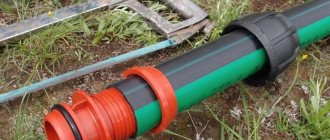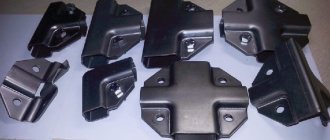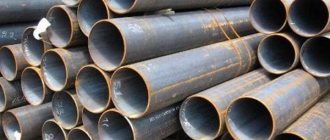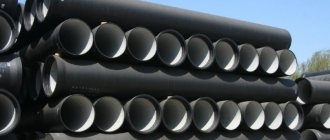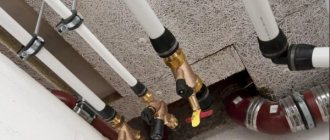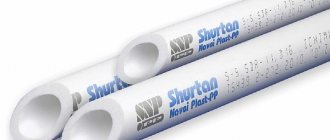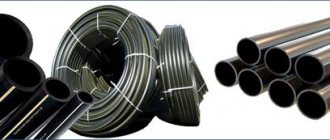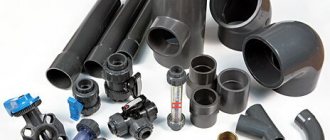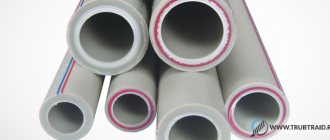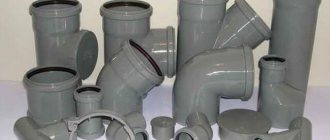Metal pipes are being used less and less for water supply installations. They are being replaced by products made from polymers. One of the varieties of such materials is HDPE - low-density polyethylene, which has good properties from the point of view of its operation in aggressive environments.
Metal pipes began to replace HDPE pipes.
HDPE pipe for water supply is a strong and durable product. It is resistant to various chemicals, so theoretically it can be used to transport various liquids. In addition, such products are distinguished by a smooth surface on which pathogenic microbes and mold do not multiply. Their advantages include low thermal conductivity. Combined with a smooth surface, this prevents condensation from forming.
Main features of the material
The industry widely uses such an organic compound as ethylene. Polyethylene is obtained from it by polymerization.
But there are 2 varieties of it. These are low-density polyethylene (HDPE) and high-pressure polyethylene (LDPE). The first is obtained at a temperature in the range of +120...+150°C at a level of 0.1-2 MPa. There is a generally accepted international abbreviation for this material - HDPE. It is characterized by high strength and density.
The second is designated as LPDE, it is obtained at a temperature of +200...+260°C and a value of 1500-300 MPa. This is a low-density material, plastic, soft, it has a completely different scope of application, while HDPE polyethylene pipe, which has good performance properties, is used for laying water pipes in private homes and summer cottages. Moreover, it is suitable for both cold and hot water supply, provided that the temperature of the medium is not higher than 40°C.
Main features of the material.
The only caveat is that when laying such networks in the ground, you need to ensure that the trenches for them pass below the freezing point of the soil, and the width exceeds the diameter of the pipe.
Also, HDPE structures have found another application - as protective boxes, which are needed for installing electrical cables. The water pipes themselves are made of this material black, so they can be distinguished even visually.
Application of polyethylene pipes
In fact, polymer cross-linking technology has been widely used for three decades, but polyethylene pipes for heating began to be used only in heated floors. The flexible tubes produced in two-hundred-meter coils are extremely easy to install, since their considerable length allows you to avoid unnecessary joints, which are considered the weak point of any communications. To seal connections, standardized fittings are made of plastic and brass, ensuring simple installation. The use of long polyethylene pipes makes it possible to extend connections above the floor level for easier access if necessary.
Warm floor under installation.
When installing heated floors, it is advisable to use products with an anti-diffusion coating that prevents the access of oxygen. It is inappropriate to use more expensive multilayer polyethylene pipes in this situation, since the temperature of the coolant is relatively low and the deformation is insignificant. But in heating networks operating at higher temperatures, multilayer products with a low elongation coefficient cannot be avoided. Only open-type heating systems require the use of polyethylene pipes that lack an anti-diffusion barrier, since oxygen penetrates inside in any case.
The warm floor is ready.
Production of polyethylene pipes
Several technologies have been developed that, depending on a number of factors, are used in the production of parts from this material.
The following methods are distinguished:
- Suspension, in which polymerization of monomer raw materials occurs in a dispersion medium (water is used as standard). In this case, a suspension is formed with the size of individual particles in the range of 50-150 nm.
- Mortar. In many ways, it resembles the previous production method, but an organic solution is used for polymerization.
- Gas-phase technology. It is characterized by the presence of a gas phase of the monomer.
With all 3 methods, you can obtain a durable and high-quality material characterized by strong bonds between molecules. But some HDPE indicators will vary depending on the selected production technology. Although for the end user, a more important role is played by the fact that all 3 methods make it possible to obtain pipes of different sections and with the required wall thickness.
Ratio of indicators
The relationship between these 2 indicators is also important. What diameters will be chosen depends on the specifics of the project.
Dimensions and markings
Marking of HDPE pipes
Each of the three grades of polyethylene has dimensions:
- external diameter from 1 to 120 cm;
- wall width from 0.5 to 5.3 cm;
- internal diameter, which determines the throughput.
The higher the planned pressure in the system, the thicker the walls of the products.
The sizes of HDPE pipes for cold water supply differ depending on the diameter. Products with a small cross-section are sold in coils. Wide ones are cut into equal pieces up to 12 m.
For home plumbing and sewerage systems, polyethylene pipes with a diameter of 50 and 110 mm are usually used. External drainage depends on the load placed on the sewer system, taking into account the number of residents.
Product requirements
The products can be used for both cold and hot water. But it is necessary that they meet the requirements set out in GOST 18599-2001.
They are required to have absolute smoothness of the internal, external and end surfaces, on which there should be no foreign inclusions, cracks, cavities, or other defects. The maximum pressure value for such pipes should be from 16 to 20 atm.
The diameters of HDPE pipes that meet these requirements are in the range of 1.6-160 cm. Such products are supplied either in the form of straight sections (their length is 12 m) or in coils of 100 or 200 m.
The part is marked with blue stripes, standardly there are at least 3 of them. They are evenly distributed around the circumference of the product.
Polypropylene
In addition to the three types of varieties, polypropylene pipes differ in wall thickness and, accordingly, withstand pressure. The most common sizes are: PN10, PN20, PN25.
What do these numbers mean? PN is the nominal internal pressure (bar) of a fluid at 20 degrees Celsius. This means that the pipe can hold this pressure without failure for 50 years.
The advantages of water supply design made from polypropylene include the cost of materials compared to water supply made from metal-plastic
. Low heat loss compared to metal-plastic. The disadvantage of using pipes for heating is that polypropylene is a porous structure. The material from which the pipe is made gradually allows oxygen to pass through. The pipe seems to breathe, saturating the liquid with oxygen. As a result, closed heating systems need to be topped up. However, since it is periodically necessary to change the coolant in the heating system, this minus turns into a plus. This is a plus for the water supply - because such water in the pipes will always be saturated with oxygen, which prevents the effect of souring and unpleasant odors.
Compared to other types of pipes, polypropylene pipes have a fairly significant thermal elongation. What is detrimental to the rigid fixation of the pipe. When assembling water supply or heating from polypropylene, it is necessary to provide for the fact of pipe movement. For example, expansion compensators are always installed at distances of more than 10 meters. They look like rings that dampen the flow of the pipe and prevent it from breaking.
Characteristics of HDPE pipes that determine their choice
To select such products, the most important indicator is their dimensions, i.e. diameter and wall thickness (as well as the ratio between them, denoted as SDR). The smaller this ratio, the greater the weight of the pipe.
In addition, you need to know the brand of polyethylene from which the product is made. There are 3 brands, designated as PE-63, PE-80 and PE-100. Of these, PE-80 is considered the most universal, since it is designed for high internal pressure and is characterized by low cost.
But pipes made from PE-100 have a higher maximum tensile strength and resistance to mechanical stress. Products made from PE-80 are used as a standard for installing water pipes with a cross-section of up to 9 cm.
Advantages and disadvantages
If we compare polyethylene pipes with steel ones, then HDPE:
- practically does not require care and maintenance;
- does not oxidize and does not release harmful substances into the liquid;
- there is less likelihood of condensation forming on the surface, since the material has low thermal conductivity;
- when the water inside freezes, the polyethylene expands in diameter and does not tear;
- the products are light in weight, so they can be installed without the use of construction equipment;
- welding plastic takes less time and is more reliable;
- fewer welds will be required, since polyethylene pipes are longer than metal pipes;
- cost reduction by 45% when replacing pipe sections;
- scale does not form on the inner surface, since the walls are very smooth and the material is chemically inert.
Disadvantages:
- Plastic pipes can be damaged due to soil mobility and therefore require additional protection.
- Availability of special equipment for welding.
- Ultraviolet radiation can damage products without special protective coating.
- Due to temperature restrictions, HDPE pipes may not be used everywhere.
The main advantage of HDPE is price. Raw materials for the production of pipes are cheap, and products made from them can compete with more expensive materials in their characteristics.
Technical characteristics of polyethylene products
The installation of a water supply system begins with its design. And to create such a project, you need to understand the technical characteristics of the pipes. They may vary for products of different diameters. But the melting point for all products will be the same - +120...+135°C.
All types of pipes can withstand frosts down to -70°C. The density of most products is 948-960 kg/cubic. m, and the specific heat capacity is in the range of 2300-2700 J/(kg*K). In this case, the characteristics of the required model can be found in the accompanying documentation.
Technology for assembling polyethylene water pipes
The assembly of individual polyethylene parts of the water supply system is carried out in two ways:
- detachable allows for easy dismantling of individual parts and is performed using flanges and compression fittings;
- one-piece creates a very durable cast structure and is carried out by butt or electrofusion welding.
The detachable method allows you to simply and quickly, without special equipment, connect individual parts of the water supply system and this is easier to do with the help of compression fittings. Such fittings are easily assembled and disassembled, replaced and make it easy to remake the entire system, and are also used for HDPE-to-metal transitions and for parts of various diameters.
If parts of small diameters are mounted, everything must be done by hand; for large diameter parts, wrenches are used. For different diameters of HDPE water pressure pipes, installation will have some differences:
- for ∅ 20-50 mm, partially disassemble the fitting, prepare the parts to be connected (clean off dirt, remove the external chamfer, mark the depth of entry into the fitting, insert the pipe into the fitting with considerable force, tighten the nut to the end of the thread;
- for ∅ 63-110 mm, a pipe and a compression fitting are prepared (disassembled into an O-ring, a thrust cup, a split locking ring), preliminary assembly is carried out without a split ring, and then the final connection is made (the split ring is put on and moved to the coupling, the nut is screwed in with a wrench).
Regarding the behavior of a permanent connection, you must follow the installation instructions for HDPE pipes and take into account that they differ for butt welding and electrofusion welding. The most technologically advanced method is butt welding, which requires not only skills, but also a special welding machine. It is precisely this that is most often used for large-diameter HDPE PE100 pressure pipes.
In this case, the ends of the parts to be joined are cleaned and degreased, chamfered at an angle of 45°, heated in a soldering iron to a viscous state and connected strictly perpendicularly under pressure, and allowed to cool. This method is not suitable for parts of different diameters and made of different substances.
More convenient to use are welded couplings or fittings that have an electric heating coil inside. This method does not require special skill, and the stages of work are the same as with the butt method, only the parts to be welded are placed in a fitting, inside which they are fused.
Advantages of pressure water pipes made of polyethylene
Pipes made of polyethylene of this type have a number of advantages compared to such traditional options as products made of cast iron, metal or even concrete.
Their advantages include:
Advantages.
- long service life - if all conditions are met, it is 50 years;
- resistance to corrosion and aggressive chemical influences;
- low cost;
- good elasticity;
- ability to withstand changing soil load;
- frost resistance, due to which such products do not require additional insulation (pipes can withstand low temperatures down to -70°C);
- light weight - pipes made of low-density polyethylene are lighter than products made of metal alloys (3-4 times);
- high installation speed and simplicity;
- high degree of environmental safety - pipes do not emit toxic substances and do not harbor pathogenic microbes.
In addition, HDPE pipes with a diameter of 2-11 cm are produced in coils, the total length of the products can be 50-1000 m, which helps reduce material consumption.
Such characteristics make HDPE structures a good choice for water supply systems for a summer residence. Moreover, they can be installed independently, although you will need a special device.
The operational and hydraulic properties of the system will be preserved even when using HDPE pipes with a diameter less than the design one. This is achieved due to the low roughness of the internal surface. The risk of water hammer for the products remains low.
What temperatures can PVC and PP pipes withstand?
Polypropylene pipes, in my opinion, are the most balanced option for water supply to a dacha. The operating temperature is from -200 to -750 C, but do not forget about the possibility of water freezing at zero.
Therefore, I recommend laying PP pipes in the ground below the freezing depth of the soil. Be sure to maintain a slope to allow water to flow from the pipe into the drain.
Someone forgot to turn off the water in the cold...
With proper installation, manufacturers promise a 50-year service life (but this is not certain). I would assemble external water supply from PP pipes with the addition of a catalyst, which makes them invulnerable to ultraviolet radiation.
Important! The system of polypropylene pipes is soldered forever, so to organize summer (collapsible) irrigation, do not forget to buy fittings for soldering.
PVC pipes are the cheapest and most unreliable option that I have found. There are no advantages, except for the low price, but there are a whole bunch of disadvantages:
- polyvinyl chloride decomposes in the sun - it becomes brittle and inflexible;
- operating temperature from -150 to +650С;
- the quality of production greatly affects the performance characteristics (you can run into outright bullshit).
From the above, I realized that PVC is the choice for the frugal. And the stingy, as we know, pays twice.
Pipe connection options
To install HDPE pipes, you need to understand how they can be connected. There are several options:
- Welding using a special apparatus, in which the ends of polyethylene products are heated to the desired temperature and then connected. It is important that the cuts are smooth. Welding connections are considered the best option for installing a water pipeline laid in a layer of soil.
- Using compression fittings. There are many varieties of such elements. These are tees, couplings, flanges and much more. With their help, systems of rather complex configurations are assembled. But this method is not suitable for water pipes that will be laid underground, since the fittings require regular maintenance.
- Electrodiffusion welding, for which thermoresistive fittings are used. A special feature is resistance to high temperatures, and from a design point they are distinguished by the presence of a heating spiral and special sensors. On their surface there are terminals for connecting the welding unit. The prepared ends of the pipes are inserted into these fittings, and then welding is started. The inner spiral of the fitting heats up during the process, the material of this hot element imparts heat to the polyethylene of the pipe, and it melts. This method is suitable for laying a pipeline in the ground.
- Flange connection. This type of joining is most often used when there is a need to switch to another type of pipe.
At the same time, the installation technology is simple. And even if you don’t have the skills, you can install HDPE pipes for the water supply system in your dacha on your own, without involving specialists, which will save money.
Thermopipe TR1 Prosafe
A special type of Thermopipe pipes, the surface of which is covered with a special protective film made of a special thermoplastic strong polymer that can protect the main surface of the pipe during the construction of a pipeline using the HDD laying method, and these pipes can also be laid in a trench without subsequently filling it with soil. This method of laying Thermopipe pipes is also used in the relining method.
The length of pipe sections in production is up to 13 meters with a diameter of over 110 millimeters.
Also, pipes are produced wound in coils from 50 to 150 meters with output diameters from 20 to 110 mm.
Below we suggest that you familiarize yourself with the summary table of the maximum operating pressure in the pipe at a constant temperature.
| Slave. t, in C | Service life (in years) | Max. slave. pressure in the presence of constant T MOP, SF=1.5 bar | |||||
| SDR | |||||||
| 21 | 17 | 13,6 | 11 | 9 | 7,4 | ||
| 40 | 50 | 5,7 | 7,1 | 9,0 | 11,3 | 14,2 | 17,7 |
| 50 | 50 | 5,1 | 6,4 | 8,1 | 10,2 | 12,8 | 16,0 |
| 60 | 50 | 4,5 | 5,7 | 7,2 | 9,1 | 11,3 | 14,2 |
| 75 | 50 | 3,7 | 4,6 | 5,8 | 7,3 | 9,1 | 11,4 |
| 80 | 30 | 3,4 | 4,2 | 5,4 | 6,8 | 8,5 | 10,6 |
| 95 | 6 | 2,6 | 3,2 | 4,1 | 5,2 | 6,5 | 8,1 |
| 110 | 1,5 | 1,8 | 2,2 | 2,8 | 3,6 | 4,5 | 5,6 |
Where can Thermopipe products be used?
Let us repeat and summarize the above about pressure pipes:
- Pipelines for hot water supply or heating;
- Pipelines for rapid transportation of various liquids and gases without exceeding the temperature above +95°C;
- Transportation of any other raw materials or fuel for domestic and industrial needs;
- Pressure pipelines in premises: for example, cold or hot water supply;
- Transportation of liquid and gaseous media with different characteristics up to +40°C within an industrial pipeline, transportation of aggressive media;
- Conduit can be used to protect electrical wires and thick cables;
- Specific use: e.g. wastewater transport, etc.
Polyethylene PE-ITtype II – explanatory description
It is thanks to PE-IT type II polyethylene that such pipe characteristics are achieved. This type of polyethylene is developed by Dow (USA), a world leader in the production of various products for the chemical industry.
Next, we publish an information matrix on the properties of the pipe, which will display its flexibility, heat resistance, chemical resistance, abrasion resistance, service life and welding. The polyethylene used is branded – DOWLEX™ PE-RT type II.
Installation of Thermopipe pipe
When installing Thermopipe brand pipes, I use old proven welding methods - the butt welding method, as well as the welding method using connecting parts with embedded heating elements, i.e. electrofusion welding.
It is also recommended to use flange connections and transitions of the polyethylene-metal type, using high-quality couplings (for example, couplings from the manufacturer STRAUB). Direct joining of steel and polyethylene materials is not possible.
To order pipes, contact our managers — +7;.
User reviews
People who have already used polyethylene pipes to create underground sewer or water supply systems shared their reviews.
Unlike metal pipes, HDPE pipes are much better in terms of environmental friendliness . This property is a very important advantage that good quality pipes should have. At least because of this quality, such pipes should be used.
Very light and easy to install. They have anti-corrosion properties , which allows them to retain their main function for a long time.
